Eric Edward Esper Gallery
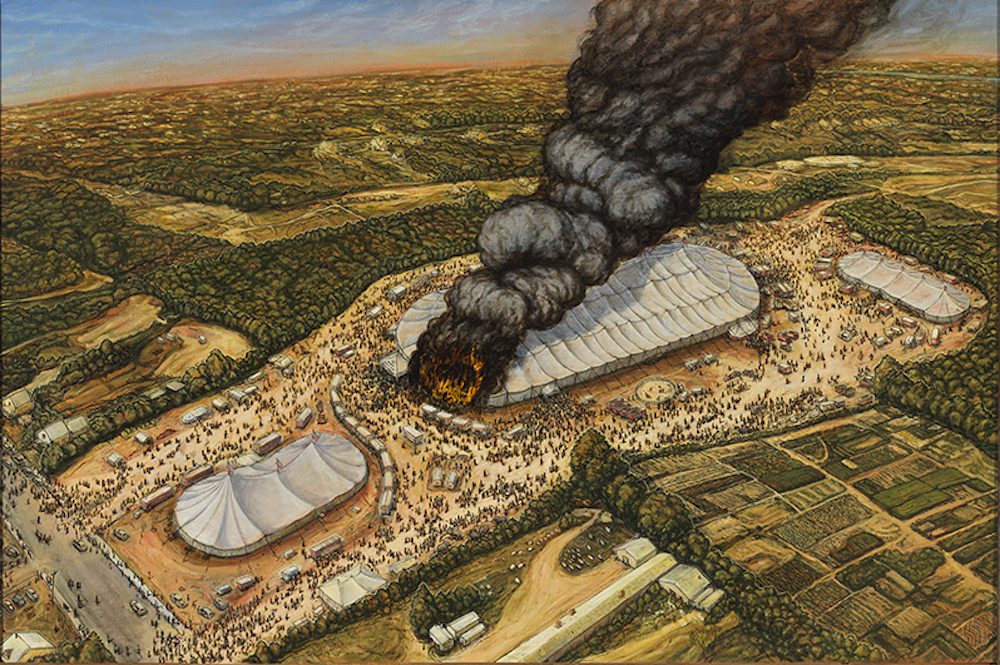
Eric Edward Esper
The Ringling Brothers Barnum & Bailey Circus Fire of 1944
oil on canvas
27 x 42 inches
price: 9,000.
There were several thousand people at the circus July 6 1944 for the mid day show. As excited spectators were watching the Flying Wallendas start their high wire act, a fire started on the sidewall of the enormous big top, and spread rapidly over the canvas waterproofed with gasoline and paraffin. As the fire burned over the crowd a panic driven stampede cause many people to become tangled in the bleachers and animal cages in the ring, trapping them inside the tent as it became completely engulfed and burned to the ground in less than 10 minutes.
This tragedy took 168 lives and injured hundreds of people yet no circus employees or animals perished.
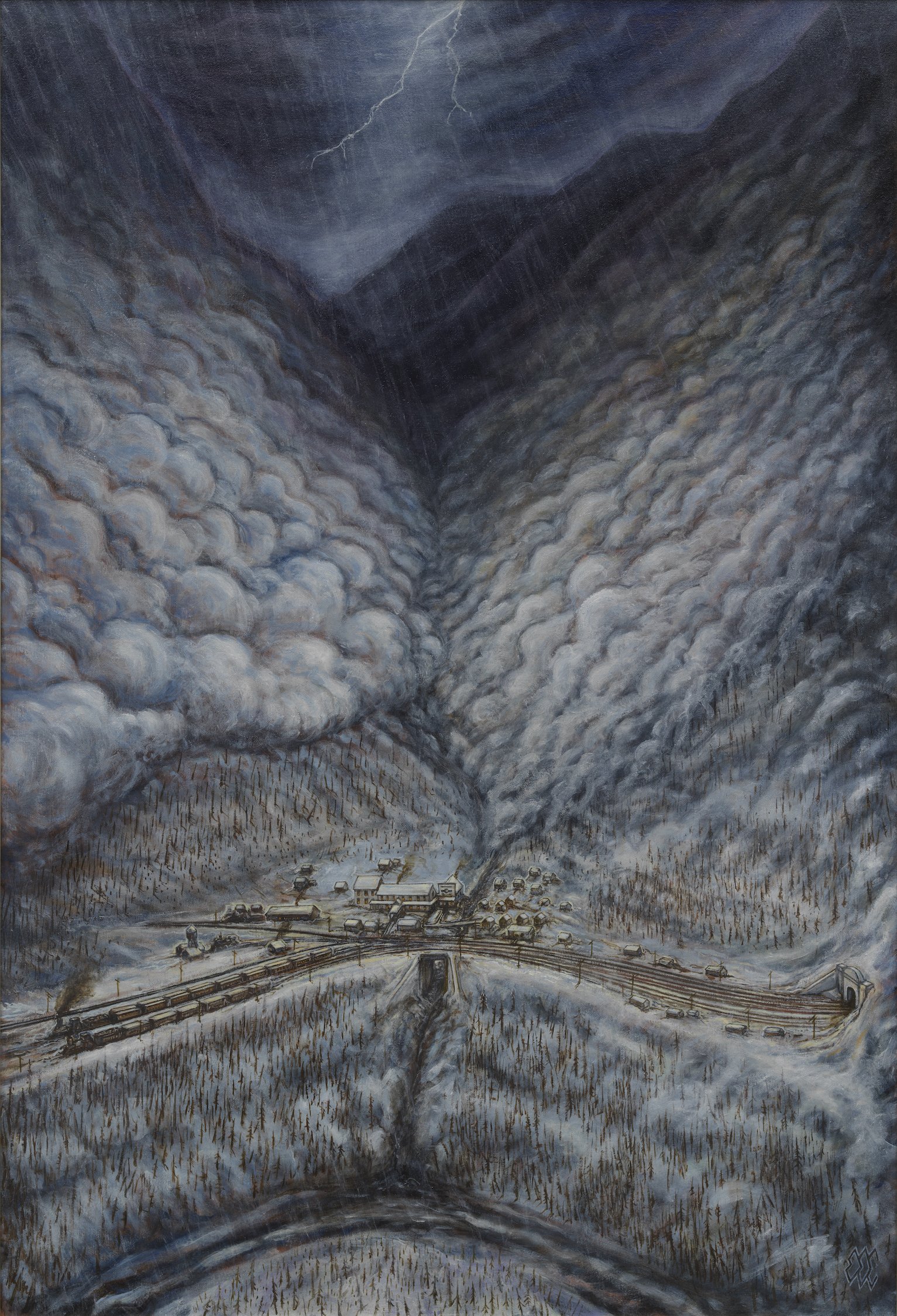
Eric Edward Esper
Wellington, Washington Avalanche of 1910
oil on canvas
38 x 26 inches
price: 8,000.
Also known as the Great Northern Railway disaster and America’s deadliest avalanche.
After days of traveling west and passing through the 2.6 mile Cascade Tunnel, the GNR passenger train was trapped by snow at the tiny town of Wellington, Washington in the Cascade Mountains. For 6 days the passengers survived on the train while railmen worked dauntlessly through continuous avalanches to clear the tracks ahead towards the next town. Fearful of the snow looming over them on the mountain above, the passengers were assured that they were safest where they were. The weather was severe and eventually an avalanche swept the GNR passenger train and a mail train off the tracks towards the river below, resulting in 96 deaths and 23 surviving injured.
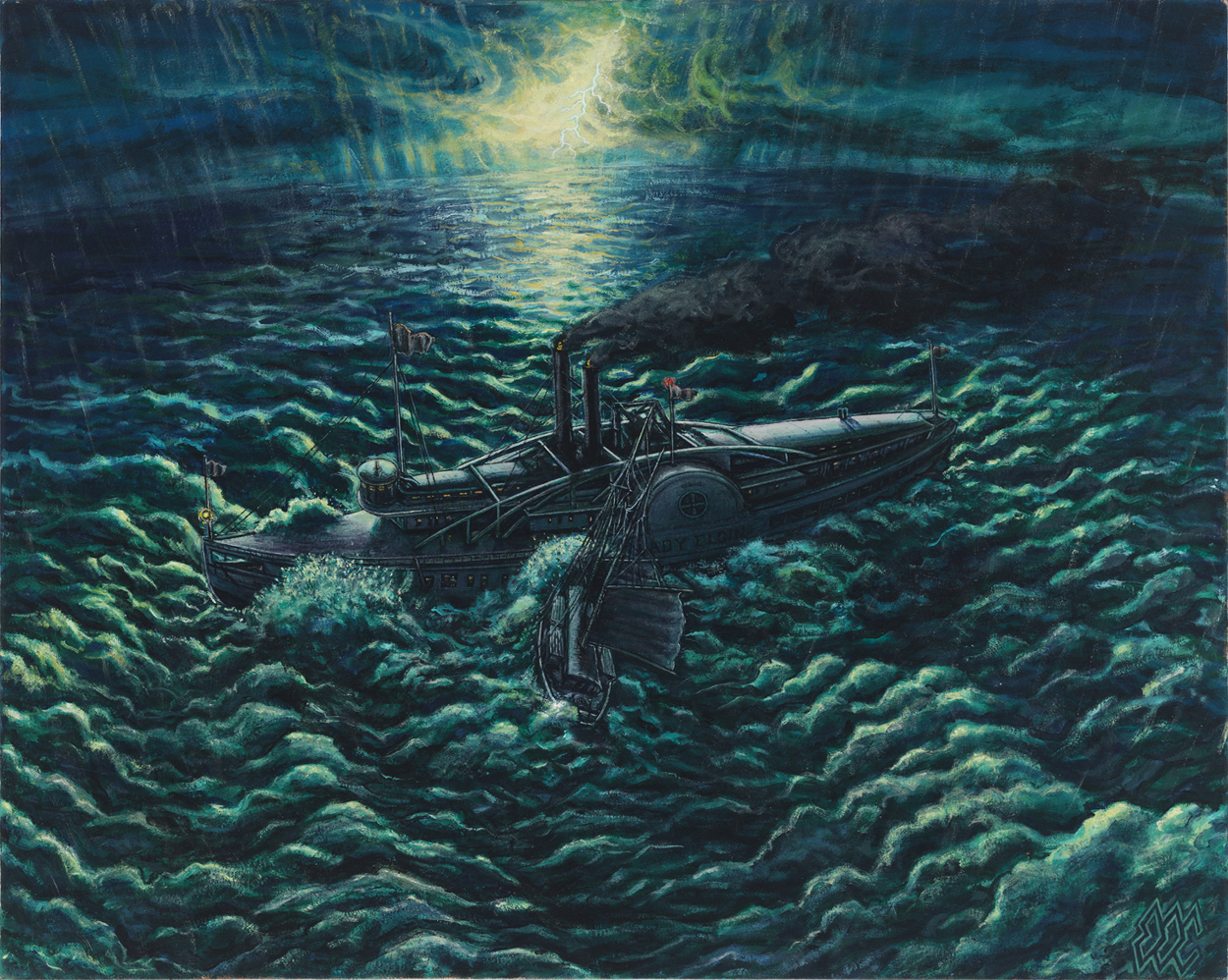
Eric Edward Esper
The Last Voyage of the Lady Elgin
oil on canvas
24 x 30 inches
price: 8,000.
On Saturday, September 8, 1860 at 2:30 a.m., the sidewheel steamship was full of Milwaukee’s Union Guard and civilians returning to Milwaukee from political rallies in Chicago. During gale force winds and thunderstorms, the Lady Elgin was struck on the port side by the schooner Augusta. Within 20 minutes, the Lady Elgin broke apart and sank as the Augusta raced to Chicago to save itself. After a perilous night, about 350-400 passengers were drifting upon flotsam in stormy waters. After several hours, and still two miles from shore, most of the survivors lost their fight to live as they succumbed to the waves breaking on the rocky shoreline. Approximately 300 perished.
The Lady Elgin disaster resulted in the greatest loss of lives in open water in the history of the Great Lakes.
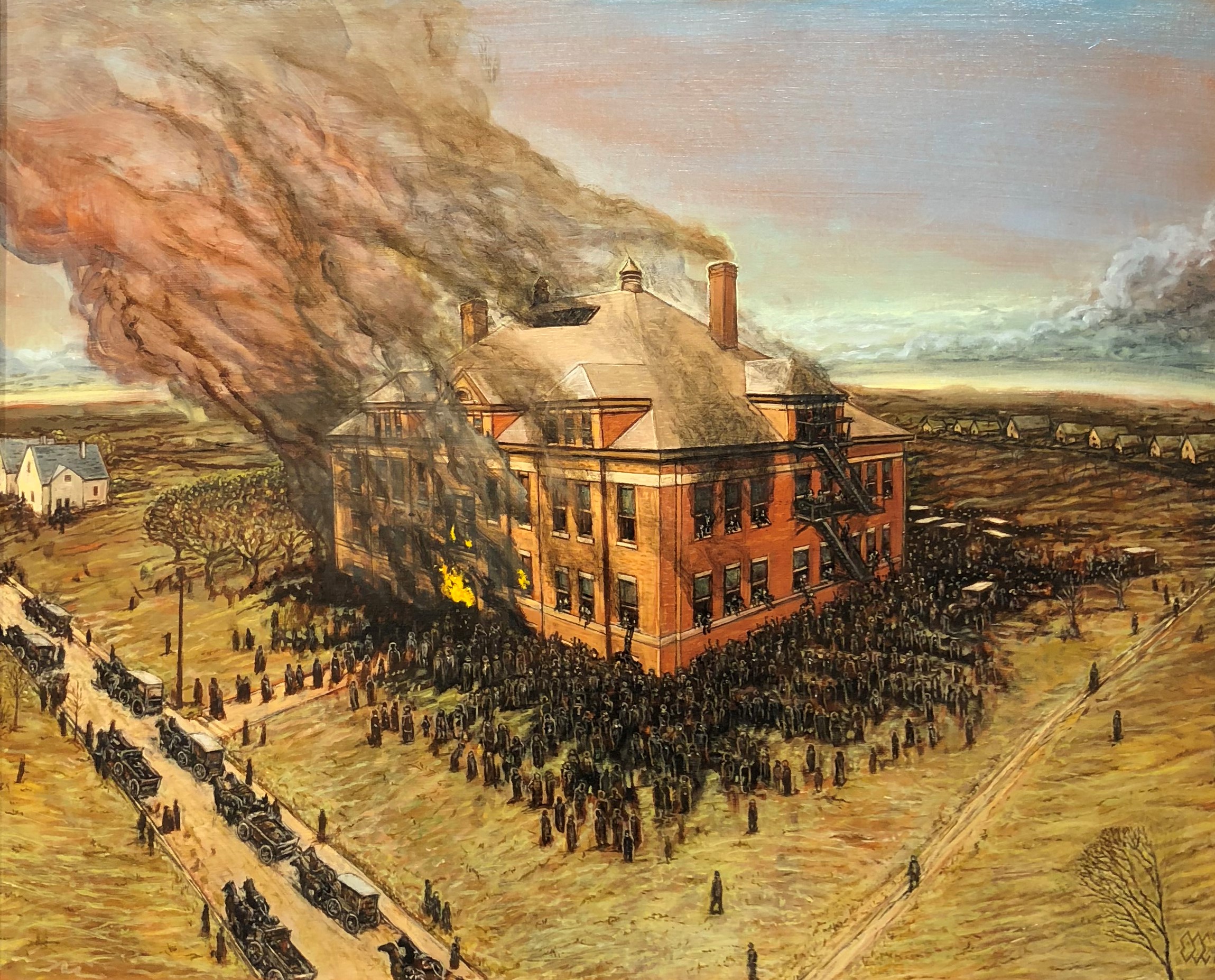
Eric Edward Esper
Collinwood School Fire, “Ash Wednesday of Ashes” March 4, 1908
oil on canvas
22 x 28 inches
price: 6,000.
At approximately 9:30 a.m. on Wednesday, March 4, 1908, a fire started in the basement near the furnace, under the front stairwell of the school, which blocked the front door. Panicked children were trapped by a crush of bodies in the doorway of the exit of the rear stairwell, trapping the rest of the students and teachers in the upper floors. The community rushed to the school for rescue efforts only to find an impenetrable wall of bodies at the doors. Unable to help, rescuers could do nothing for nearly four hours but watch in horror as some children jumped from the windows to escape, while others remained trapped in the inferno. Firefighters eventually arrived from 10 miles away in nearby Cleveland, but they were too late. 175 perished including two teachers and one rescue worker.
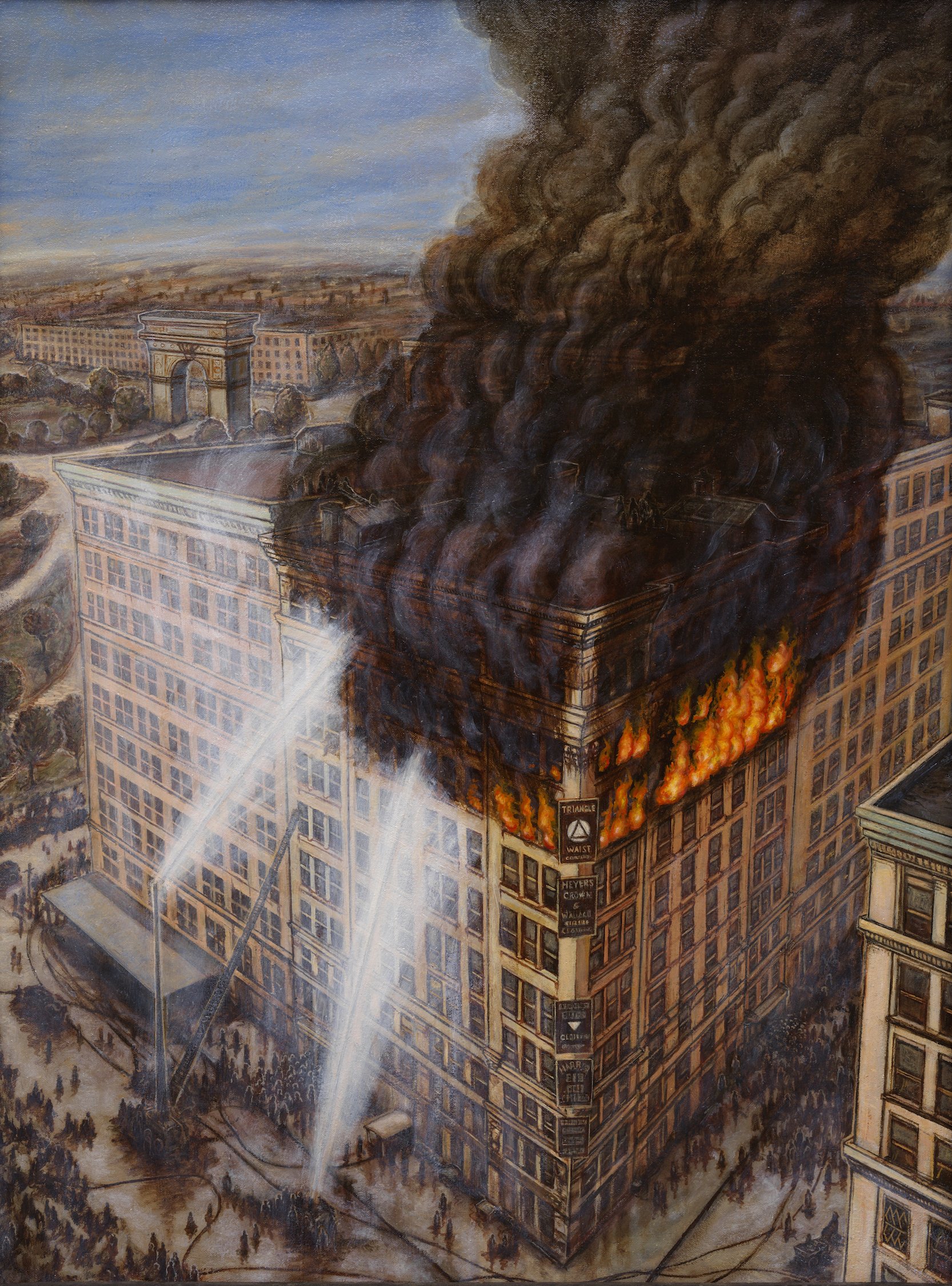
Eric Edward Esper
The Triangle Shirtwaist Factory Fire of 1911
oil on canvas
32 x 24 inches
SOLD
March 25th, 1911, Greenwich village, Manhattan, New York.
The epitome of sweatshop labor, the Triangle Shirtwaist Factory was a harsh and grueling workplace. During a time of large movements for workers and women rights, and talks of labor unions, The owners of the factory were overly strict and frugal. The approximately 500 employees working that day on the 8th, 9th, and 10th floor of the Asch Building were working in rows of sewing machines and flammable materials with all exit doors locked. Just before quitting time a fire started on the 8th floor, probably from a cigarette, spread rapidly and consumed most of the top 3 floors. It was difficult for the panicked employee’s to escape because the stairwell doors were locked, the elevators saved many peoples lives until they became inoperable, and the rear fire escape eventually became overloaded and collapsed. Some resorted to jumping from the windows. In the aftermath 146 people perished and 78 were injured, mostly women.
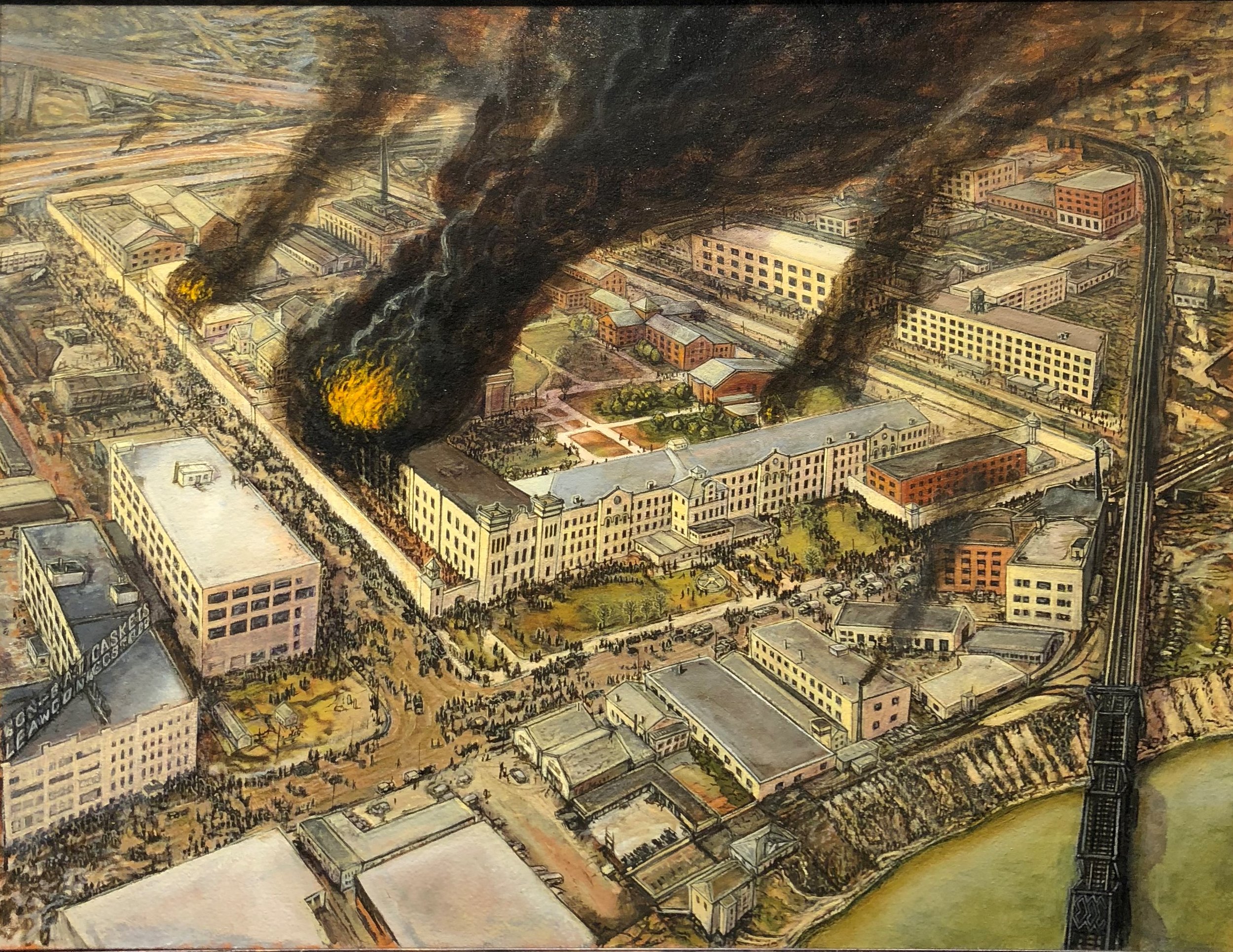
The Ohio State Penitentiary Fire of 1930
oil on Canvas
26 x 34 inches
price: 8,000.
After 100 years of brutal history at the Ohio State Penitentiary, the botched escape attempt of 3 prisoners caused the deaths of 322 men. On April 21, 1930, a crude wick did not start a planned (by the 3 escapees) fire in 2 empty cellblocks under construction until after 5:00 p.m. when all of the prisoners were locked in their cells. At 5:53 p.m., all electrical power went out and the phones went dead. By 6:00 p.m., the roof was engulfed in flames that soon spread to the occupied cellblocks where men were burned alive while locked in their cells. The roof then collapsed, crushing the trapped prisoners.
The Ohio militia and guardsmen were called to control the prisoners, but the local fire department was not called until it was too late to control the fire, which blazed until 7:30 p.m. There were many accounts of the heroic efforts of the prison guards, and prisoners alike, who risked their lives attempting to save others. But, unfortunately, in a structure designed to imprison men like this, rescue was difficult.
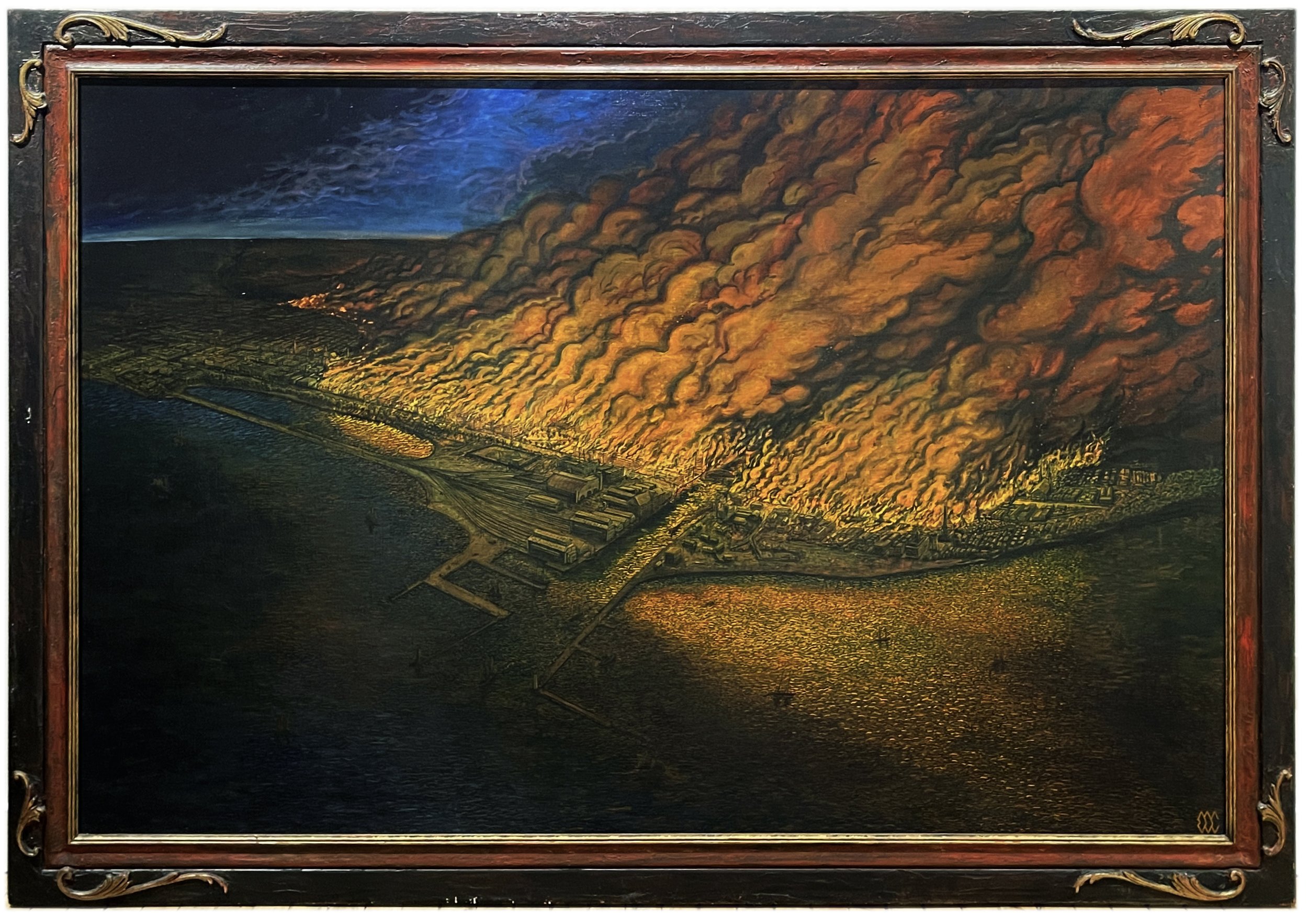
Eric Edward Esper
The Great Chicago Fire of 1871
oil on canvas
55.5 × 78.5 inches framed
SOLD
One of the most famous events in Chicago history, the Great Fire changed everything for the city. After starting mysteriously at the O’Leary barn, the fire was swept north by the wind. The depleted city firefighters were still recovering from fighting large fires the night before. Jumping the river, the wooden city fed the fire for nearly two days. The fire reached across four square miles, causing 222 million dollars in property loss, leaving 100,000 people homeless and killing an estimated 300 people.
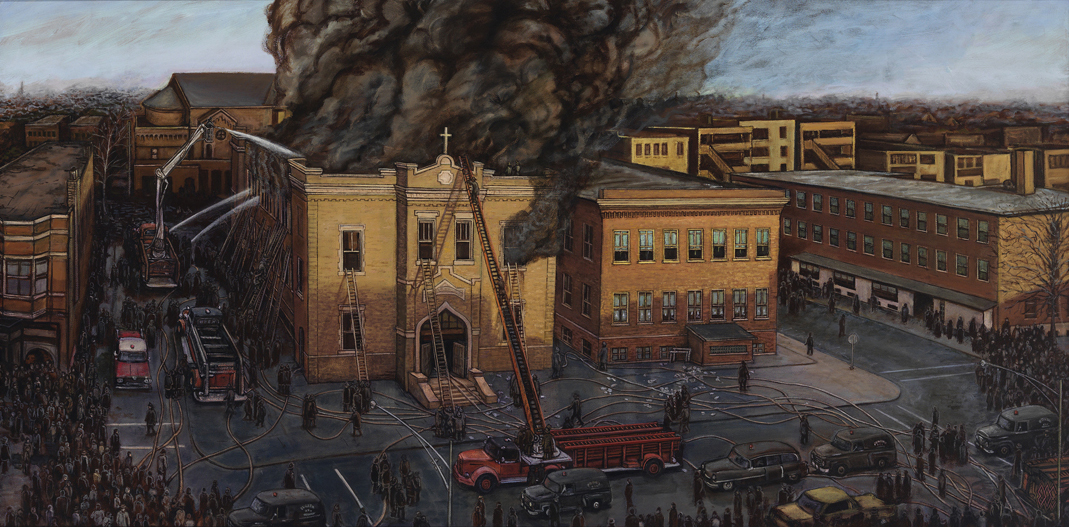
Eric Edward Esper
Our Children of Angels
oil on canvas
24 x 48 inches
price: 10,000.
Around 2:30 PM Monday December 1 1958, the schoolchildren of Our Lady Of Angels were almost ready to leave school for the day when they suddenly realized the hallways were filled with smoke. Many of the students and their teachers assumed that they were trapped and resorted to praying, some jumping from second story windows. As neighborhood parents ran to the scene with ladders too short to reach the windows, the fire department arrived in time to pull children from the engulfed second floor, but could not save 92 children and three nuns. The aftermath shattered the community with many children critically burned and emotionally damaged.
A subsequent investigation determined a student lit a fire in the basement stairwell.
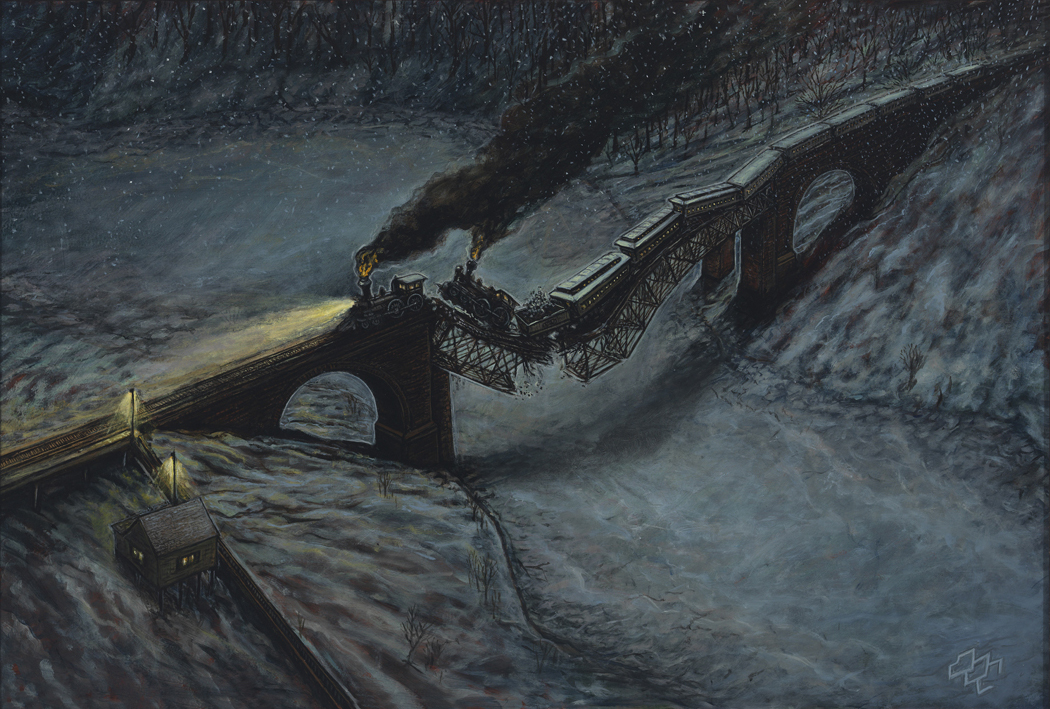
Eric Edward Esper
Ashtabula Train Trestle Collapse
oil on canvas
20 x 30 inches
SOLD
On Friday, December 29, 1876 at 7:23 p.m., after two days of blizzard conditions with 20 inches of snow and 55 mph winds, the #5 Pacific Express train from Erie, PA was running behind schedule as it traversed the Lakeshore and Michigan Southern Railway at a mere 10 mph. As the train progressed, it pushed through the snow over the 154 foot long trestle, 82 feet above the Ashtabula Creek. The lead locomotive, “Socrates,” barely made it across the creek as the metal bridge structure collapsed under the following cars. 11 cars containing 128-200 passengers plummeted to the frozen river below. The survivors at the crash site were trapped in the wreckage which had caught on fire, as well as being stuck in the frigid, icy water.
Rescue efforts were hindered due to the location and the inclement weather. Not all of the dead could be identified because no-one knew exactly how many passengers were on board. On January 19, 1877, 19 unidentified were buried at Chestnut Grove Cemetery.
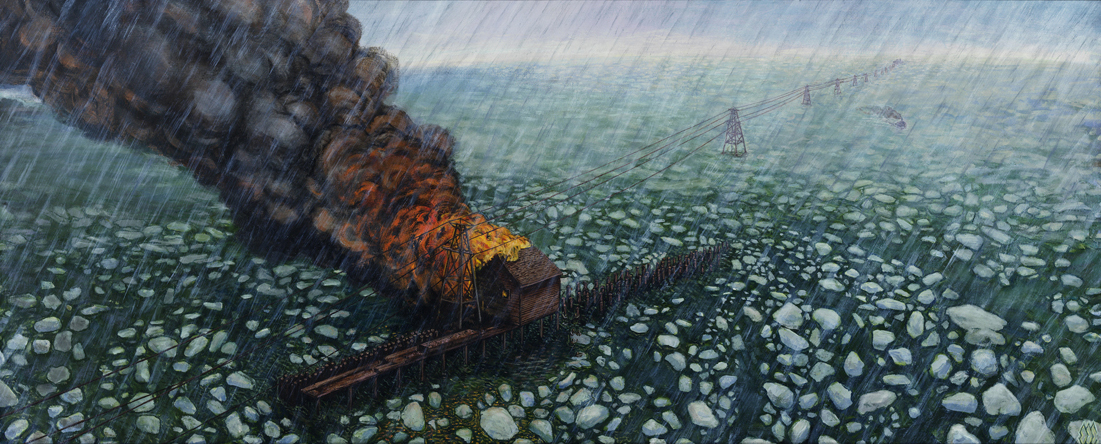
Eric Edward Esper
The Chicago Water Crib Fire
oil on canvas
20 x 48 inches
SOLD
Wednesday January 20th 1909, one mile offshore on the Chicago south side, at 70th Street, approximately 100 workers were living on the intermediate crib. This structure was atop a shaft leading 180 feet down to a tunnel the workers were digging between the water crib, a mile further out, and the shore to bring fresh water to the city. As fire broke out on that cold morning, men jumped into the icy water to escape the flames. Soon, the tugboat TT Morford, seeing the flames from the crib came to the rescue, saving around 20 lives.
But, since the men were all poor immigrants, the death toll was an estimate and much remains a mystery surrounding the fire.
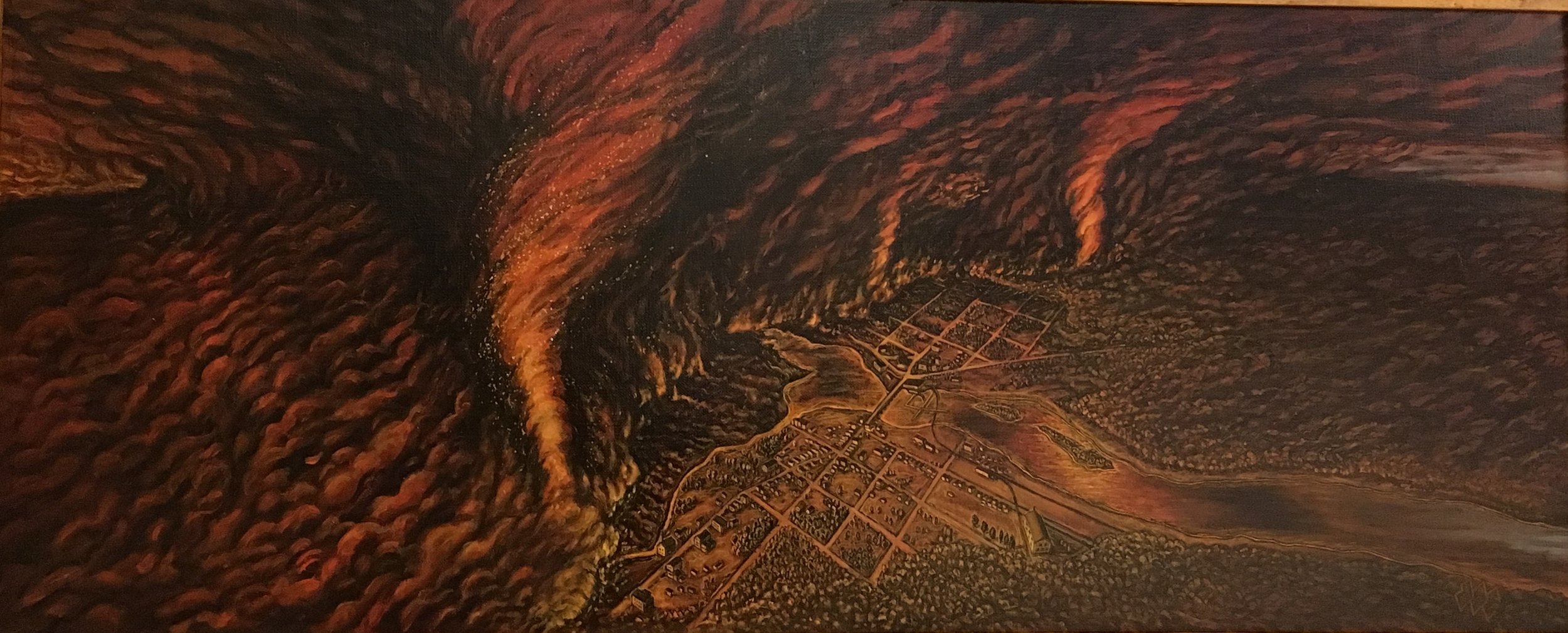
Eric Edward Esper
The Firestorm of Peshtigo
oil on canvas
16 x 20 inches
price: 4,000.
October 8 1871, the same night of the Great Fire of Chicago, and The Michigan forest fires. A cold front moved in from the west fanning land clearance fires out of control, reaching tornado force winds of up to 100 mile per hour, moving a wall of flame 5 miles wide across vast forests of northeast Wisconsin. It burned more than 1800 square miles or 1.2 million acres along both coasts of Green Bay 100 miles north to Michigan, destroying 12 communities, and an estimated death toll of 1200- 2500 people. Pestigo city had approximately 1750 residents at the time and had to bury more than 350 unidentified bodies in a mass grave.
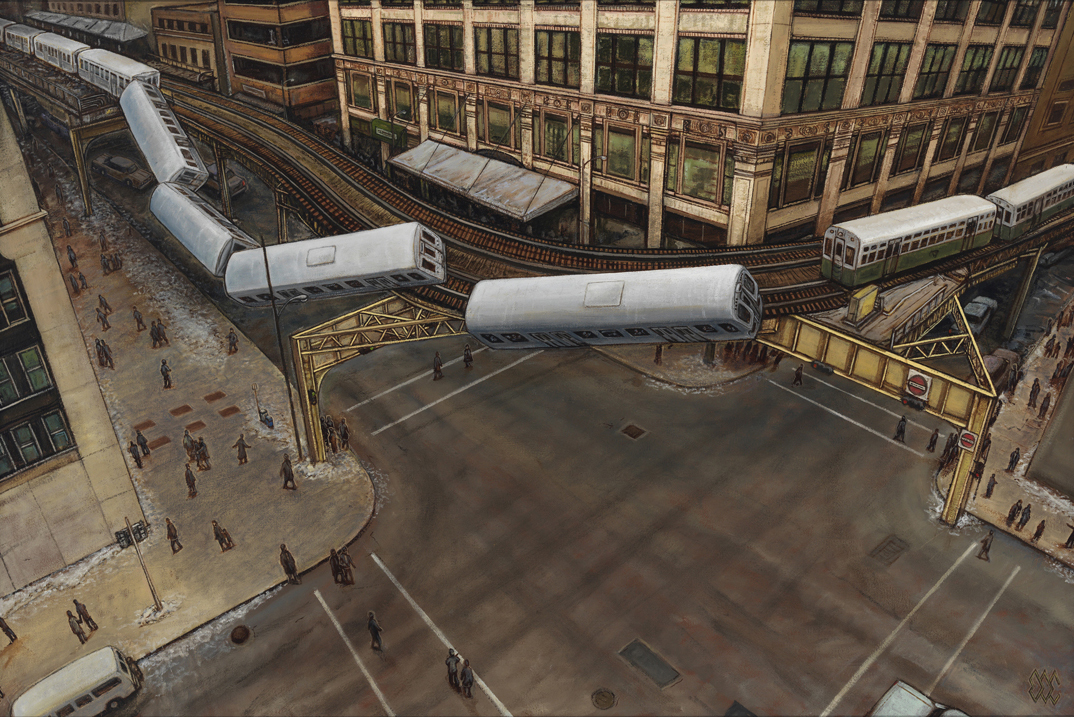
Eric Edward Esper
1977 CTA Train Derailment
oil on canvas
24 x 36 inches
SOLD
During rush hour on Friday evening, February 4th, 1977, hundreds of passengers were commuting home from work for the weekend. Everything was normal aboard the Lake/Dan Ryan line as it turned the corner at Lake and Wabash. Just after turning the corner, however, the operator failed to stop before bumping into the stopped train in front of it. Since the train was moving slowly, the impact was very slight, but the operator applied full power to the accelerator, causing the rear cars to push the four front cars off the elevated tracks to the crowded sidewalks and intersection below, resulting in 11 dead and 183 injured.
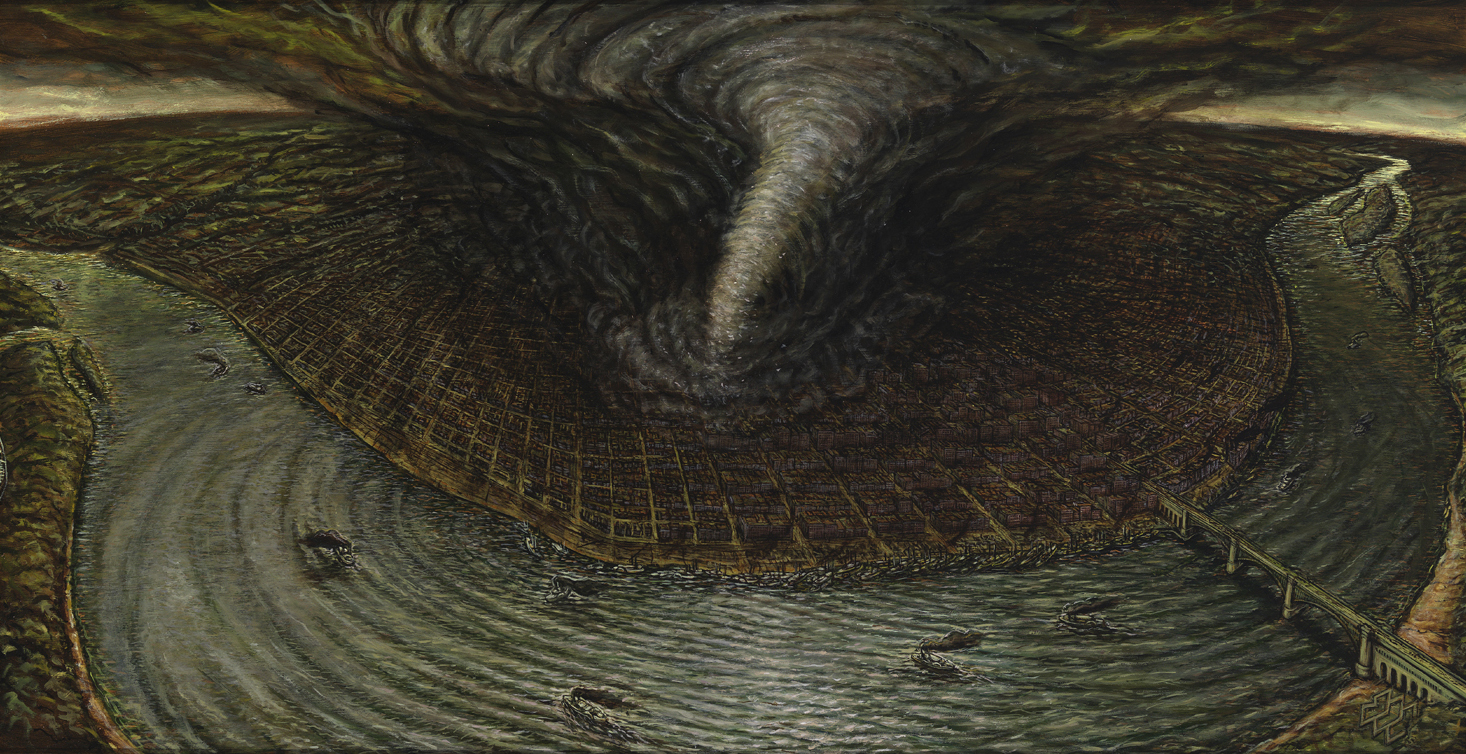
Eric Edward Esper
The Great Cyclone of St. Louis
oil on canvas
20 x 40 inches
price: 8,000.
On Wednesday, May 27, 1896, shortly after 5 p.m., there occurred a major outbreak of tornadoes across the central and eastern U.S., lasting two days. A funnel cloud destroyed a path one mile-wide and ten miles long through America’s 4th largest city. In 20 minutes, “the Cyclone” killed an estimated 255 people, left thousands homeless, and caused over 10 million dollars-worth of damage across St. Louis and East St. Louis. To this day, it remains the deadliest incident in the city’s history.

Eric Edward Esper
The Final Flight of the Wingfoot Express
oil on canvas
36 x 24 inches
SOLD
On Monday, July 21, 1919 at 4:55 p.m., a promotional flight of an experimental prototype of the Goodyear blimp flew over downtown Chicago toward The White City Amusement Park. The Wingfoot Air Express’s engine caught fire. As it drifted over the Illinois Trust and Savings Bank at LaSalle and Jackson, the five men on board attempted to escape overboard with parachutes. The pilot and chief mechanic jumped to safety. One man’s parachute caught fire, another’s got caught on the dirigible, and one man broke his legs upon landing his parachute and later died in the hospital. The burning blimp plummeted hundreds of feet, crashing through the huge skylight roof in the main banking hall of the Illinois Trust and Savings Bank, where 150 employees were preparing to leave work. Ten were killed and twenty-seven injured.
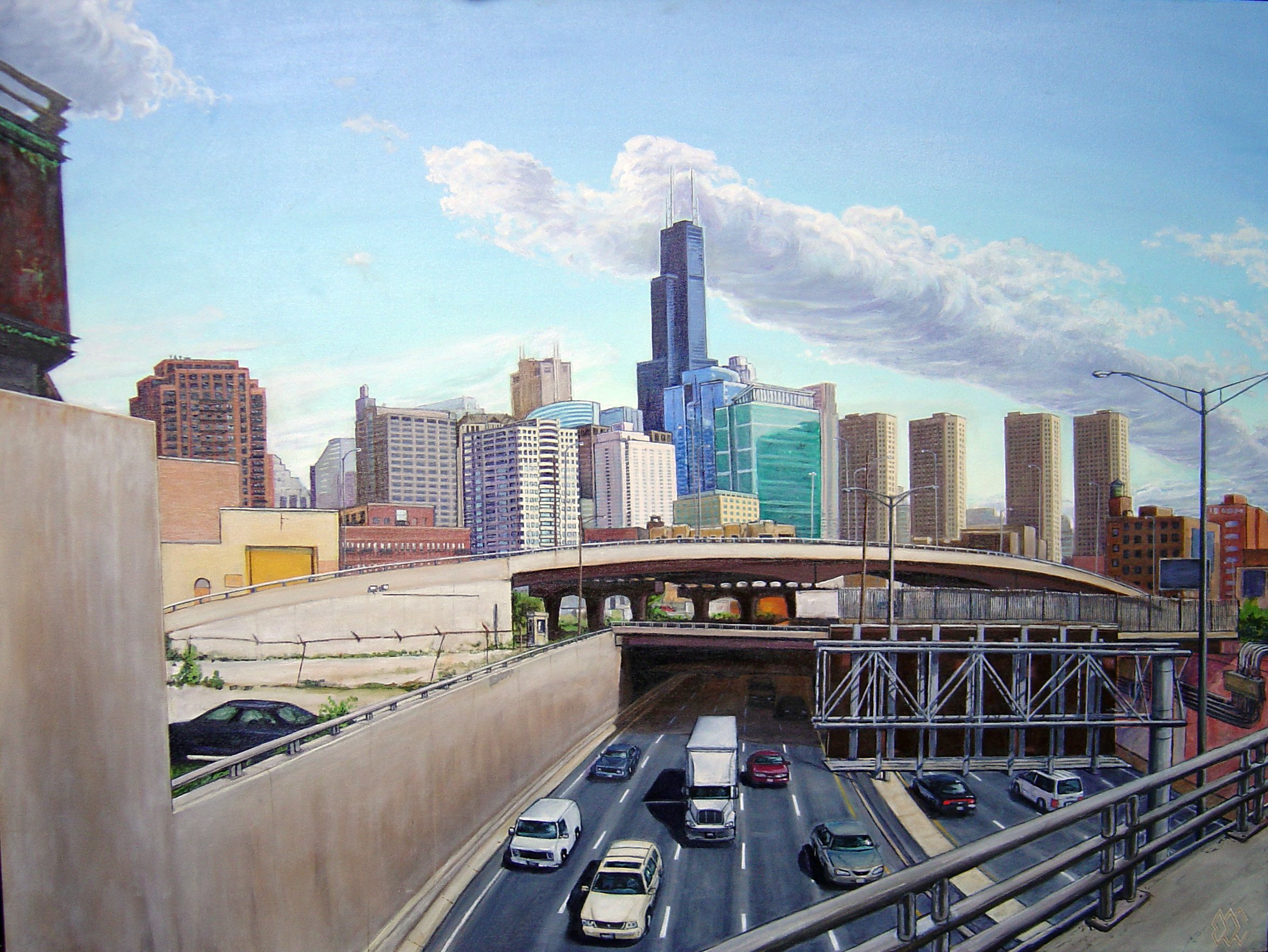
Eric Edward Esper
Hubbards Cave
oil on canvas
36 x 49 inches
SOLD
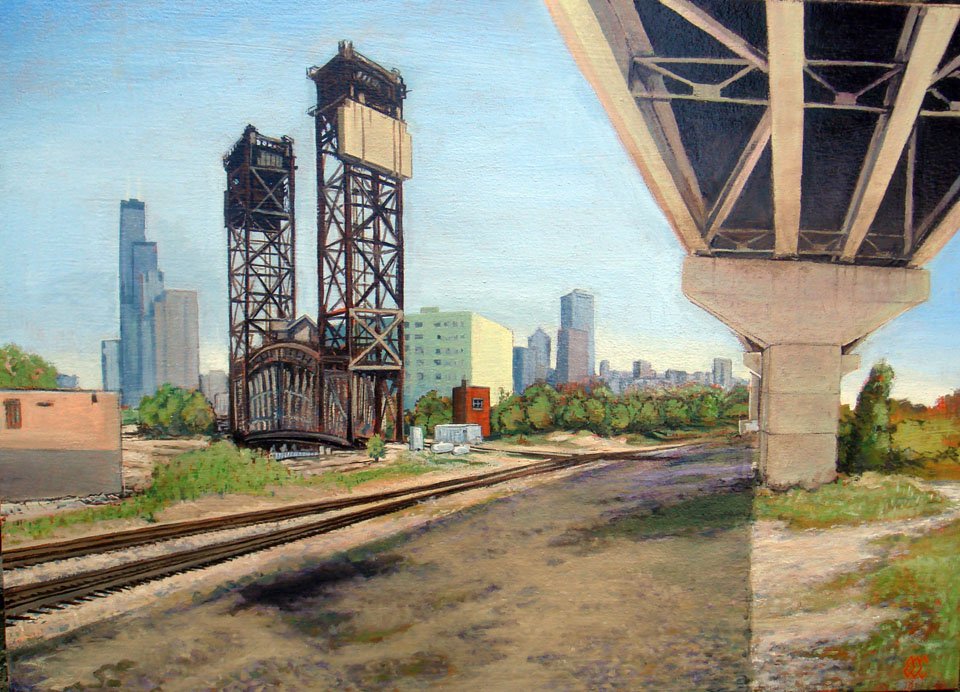
Eric Edward Esper
The Towers
oil on canvas
18 x 25 inches
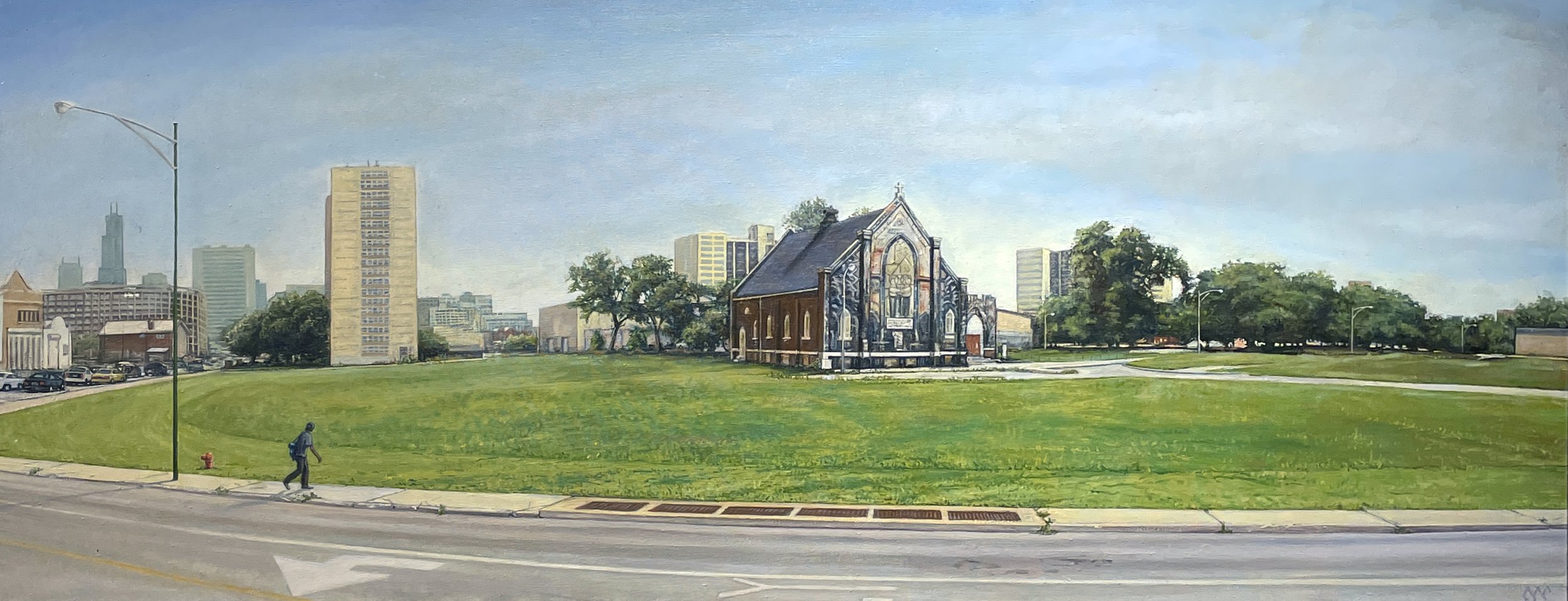
Eric Edward Esper
Strangers Home
oil on canvas
17 x 44 inches
